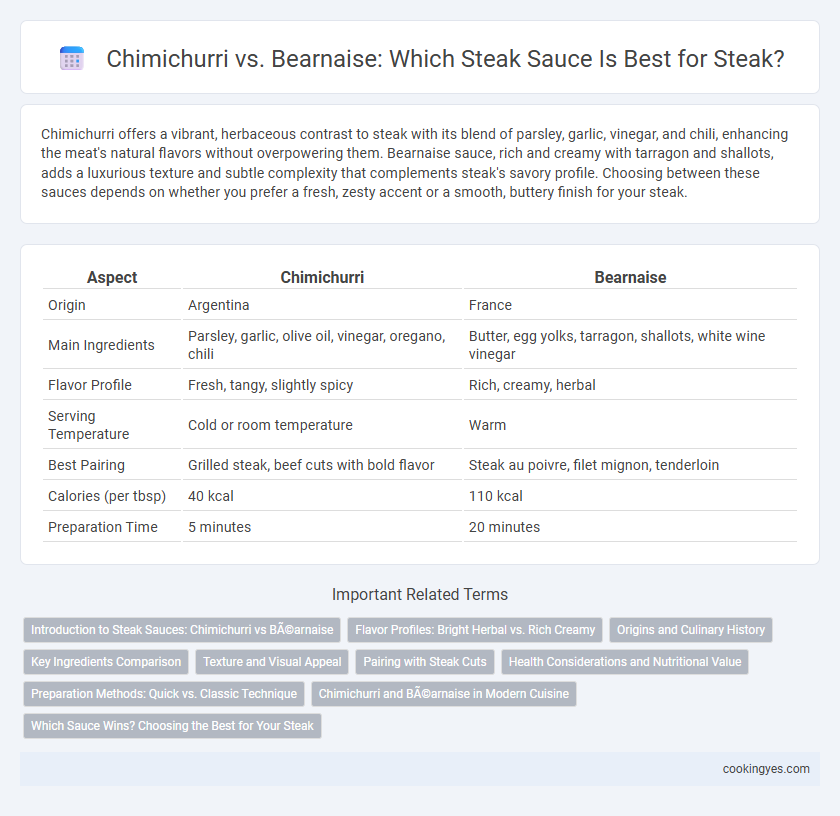Chimichurri offers a vibrant, herbaceous contrast to steak with its blend of parsley, garlic, vinegar, and chili, enhancing the meat's natural flavors without overpowering them. Bearnaise sauce, rich and creamy with tarragon and shallots, adds a luxurious texture and subtle complexity that complements steak's savory profile. Choosing between these sauces depends on whether you prefer a fresh, zesty accent or a smooth, buttery finish for your steak.
Table of Comparison
| Aspect | Chimichurri | Bearnaise |
|---|---|---|
| Origin | Argentina | France |
| Main Ingredients | Parsley, garlic, olive oil, vinegar, oregano, chili | Butter, egg yolks, tarragon, shallots, white wine vinegar |
| Flavor Profile | Fresh, tangy, slightly spicy | Rich, creamy, herbal |
| Serving Temperature | Cold or room temperature | Warm |
| Best Pairing | Grilled steak, beef cuts with bold flavor | Steak au poivre, filet mignon, tenderloin |
| Calories (per tbsp) | 40 kcal | 110 kcal |
| Preparation Time | 5 minutes | 20 minutes |
Introduction to Steak Sauces: Chimichurri vs Béarnaise
Chimichurri offers a vibrant, herbaceous flavor profile with parsley, garlic, vinegar, and olive oil, perfectly complementing the rich, grilled taste of steak. Bearnaise sauce, made from clarified butter, egg yolks, tarragon, and shallots, provides a creamy, tangy texture that enhances the meat's succulence and adds depth to each bite. Choosing between chimichurri and Bearnaise depends on whether a fresh, zesty accent or a luxurious, velvety finish best suits your steak preference.
Flavor Profiles: Bright Herbal vs. Rich Creamy
Chimichurri offers a bright herbal flavor profile with vibrant notes of parsley, garlic, and vinegar that enhance the natural taste of steak without overpowering it. Bearnaise provides a rich creamy texture with buttery, tarragon-infused flavors that add depth and indulgence to the meat. Choosing between these sauces depends on whether you prefer a fresh, acidic complement or a smooth, savory finish for your steak.
Origins and Culinary History
Chimichurri, originating from Argentina and Uruguay, is a vibrant sauce made with parsley, garlic, vinegar, and oil, deeply rooted in South American grilling traditions linked to the gaucho culture. Bearnaise sauce, developed in 19th-century France, is a classic emulsion of clarified butter, egg yolks, white wine vinegar, and herbs like tarragon, designed to complement French steaks with its rich, tangy flavor. Both sauces reflect their regions' culinary history, with Chimichurri embodying rustic, grilled meat pairings and Bearnaise showcasing refined French gastronomy.
Key Ingredients Comparison
Chimichurri, a vibrant Argentine sauce, features key ingredients like fresh parsley, garlic, red wine vinegar, olive oil, and crushed red pepper flakes, offering a tangy and herbaceous flavor profile ideal for grilled steak. In contrast, Bearnaise sauce is a rich French emulsion made with clarified butter, egg yolks, white wine vinegar, shallots, and tarragon, delivering a creamy and slightly tangy complement to tender cuts of steak. The herbaceous, acidic punch of chimichurri contrasts sharply with the smooth, buttery texture and nuanced aromatics of bearnaise, making ingredient choice crucial based on desired flavor intensity and mouthfeel.
Texture and Visual Appeal
Chimichurri boasts a vibrant, chunky texture with finely chopped parsley, garlic, and red pepper flakes that create a visually striking green and red contrast against a steak's seared surface. Bearnaise offers a smooth, creamy consistency with a pale yellow hue, enriched by tarragon and shallots that lend an elegant, velvety finish. The bright, fresh appearance of chimichurri enhances a steak's rustic appeal, while Bearnaise complements with a rich, luxurious look and mouthfeel.
Pairing with Steak Cuts
Chimichurri's herbaceous, tangy profile complements leaner cuts like flank or skirt steak by enhancing their natural flavors without overpowering them. Bearnaise sauce, rich with butter and tarragon, pairs exceptionally well with tender, marbled cuts like ribeye or filet mignon, elevating their buttery texture. Choosing between these sauces depends on the steak cut's fat content and flavor intensity to achieve the perfect balance.
Health Considerations and Nutritional Value
Chimichurri sauce, made primarily from fresh parsley, garlic, olive oil, and vinegar, offers a low-calorie, antioxidant-rich option packed with vitamins A, C, and K, promoting heart health and reducing inflammation. Bearnaise sauce, typically composed of butter, egg yolks, and tarragon, is higher in saturated fat and cholesterol, which may impact cardiovascular health if consumed excessively. Choosing chimichurri enhances steak's nutritional profile with fewer calories and beneficial phytochemicals, whereas bearnaise provides a richer flavor profile but requires mindful portion control due to its calorie density.
Preparation Methods: Quick vs. Classic Technique
Chimichurri for steak is prepared quickly by blending fresh parsley, garlic, red wine vinegar, and olive oil, creating a vibrant, uncooked sauce that enhances steak's natural flavors. Bearnaise sauce requires a classic French technique involving emulsifying egg yolks and clarified butter over gentle heat, infused with shallots, tarragon, and white wine vinegar, resulting in a rich and creamy texture. The contrast between chimichurri's raw, herbaceous freshness and Bearnaise's slow-cooked, velvety consistency highlights distinct preparation methods suited to different steak experiences.
Chimichurri and Béarnaise in Modern Cuisine
Chimichurri, a vibrant Argentine sauce made from parsley, garlic, vinegar, and olive oil, infuses steak with fresh, herbal notes that complement its rich flavor in modern cuisine. Bearnaise, a classic French sauce crafted from clarified butter, egg yolks, white wine vinegar, and tarragon, offers a creamy, tangy contrast that enhances the steak's texture and depth. Both sauces remain staples in upscale dining, with chimichurri favored for its bright acidity and bearnaise celebrated for its luxurious smoothness.
Which Sauce Wins? Choosing the Best for Your Steak
Chimichurri wins for steak lovers seeking a vibrant, herbaceous kick with fresh parsley, garlic, olive oil, and red wine vinegar that enhances the meat's natural flavors without overpowering. Bearnaise offers a rich, creamy contrast with its tarragon, shallots, and clarified butter base, ideal for those craving indulgence and a velvety texture. Selecting the best depends on whether you prefer a zesty, tangy complement with a South American flair or a classic French sauce delivering depth and luxury to your steak experience.
Chimichurri vs Béarnaise for steak sauce Infographic

 cookingyes.com
cookingyes.com